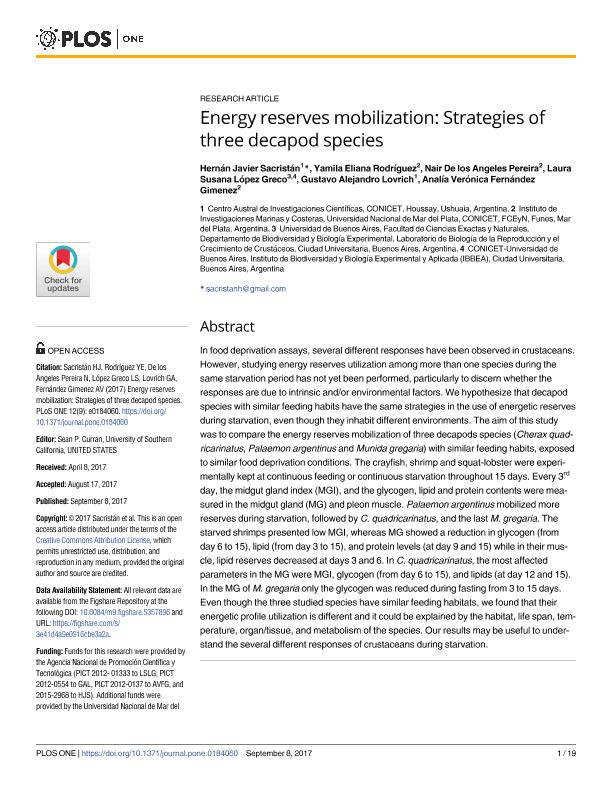Mostrar el registro sencillo del ítem
dc.contributor.author
Sacristán, Hernán Javier

dc.contributor.author
Rodriguez, Yamila Eliana

dc.contributor.author
Pereira, Nair de Los Angeles

dc.contributor.author
Lopez, Laura Susana

dc.contributor.author
Lovrich, Gustavo Alejandro

dc.contributor.author
Fernandez Gimenez, Analia Veronica

dc.date.available
2018-08-29T17:36:05Z
dc.date.issued
2017-09
dc.identifier.citation
Sacristán, Hernán Javier; Rodriguez, Yamila Eliana; Pereira, Nair de Los Angeles; Lopez, Laura Susana; Lovrich, Gustavo Alejandro; et al.; Energy reserves mobilization: Strategies of three decapod species; Public Library of Science; Plos One; 12; 9; 9-2017; 1-19; e0184060
dc.identifier.uri
http://hdl.handle.net/11336/57525
dc.description.abstract
In food deprivation assays, several different responses have been observed in crustaceans. However, studying energy reserves utilization among more than one species during the same starvation period has not yet been performed, particularly to discern whether the responses are due to intrinsic and/or environmental factors. We hypothesize that decapod species with similar feeding habits have the same strategies in the use of energetic reserves during starvation, even though they inhabit different environments. The aim of this study was to compare the energy reserves mobilization of three decapods species (Cherax quadricarinatus, Palaemon argentinus and Munida gregaria) with similar feeding habits, exposed to similar food deprivation conditions. The crayfish, shrimp and squat-lobster were experimentally kept at continuous feeding or continuous starvation throughout 15 days. Every 3rd day, the midgut gland index (MGI), and the glycogen, lipid and protein contents were measured in the midgut gland (MG) and pleon muscle. Palaemon argentinus mobilized more reserves during starvation, followed by C. quadricarinatus, and the last M. gregaria. The starved shrimps presented low MGI, whereas MG showed a reduction in glycogen (from day 6 to 15), lipid (from day 3 to 15), and protein levels (at day 9 and 15) while in their muscle, lipid reserves decreased at days 3 and 6. In C. quadricarinatus, the most affected parameters in the MG were MGI, glycogen (from day 6 to 15), and lipids (at day 12 and 15). In the MG of M. gregaria only the glycogen was reduced during fasting from 3 to 15 days. Even though the three studied species have similar feeding habitats, we found that their energetic profile utilization is different and it could be explained by the habitat, life span, temperature, organ/tissue, and metabolism of the species. Our results may be useful to understand the several different responses of crustaceans during starvation.
dc.format
application/pdf
dc.language.iso
eng
dc.publisher
Public Library of Science

dc.rights
info:eu-repo/semantics/openAccess
dc.rights.uri
https://creativecommons.org/licenses/by-nc-sa/2.5/ar/
dc.subject
Energy Reserves
dc.subject
Decapod
dc.subject
Starvation
dc.subject
Reserves Movilization
dc.subject.classification
Otras Ciencias Biológicas

dc.subject.classification
Ciencias Biológicas

dc.subject.classification
CIENCIAS NATURALES Y EXACTAS

dc.title
Energy reserves mobilization: Strategies of three decapod species
dc.type
info:eu-repo/semantics/article
dc.type
info:ar-repo/semantics/artículo
dc.type
info:eu-repo/semantics/publishedVersion
dc.date.updated
2018-08-21T13:46:13Z
dc.identifier.eissn
1932-6203
dc.journal.volume
12
dc.journal.number
9
dc.journal.pagination
1-19; e0184060
dc.journal.pais
Estados Unidos

dc.journal.ciudad
San Francisco
dc.description.fil
Fil: Sacristán, Hernán Javier. Consejo Nacional de Investigaciones Científicas y Técnicas. Centro Austral de Investigaciones Científicas; Argentina
dc.description.fil
Fil: Rodriguez, Yamila Eliana. Consejo Nacional de Investigaciones Científicas y Técnicas. Centro Científico Tecnológico Conicet - Mar del Plata. Instituto de Investigaciones Marinas y Costeras. Universidad Nacional de Mar del Plata. Facultad de Ciencia Exactas y Naturales. Instituto de Investigaciones Marinas y Costeras; Argentina
dc.description.fil
Fil: Pereira, Nair de Los Angeles. Consejo Nacional de Investigaciones Científicas y Técnicas. Centro Científico Tecnológico Conicet - Mar del Plata. Instituto de Investigaciones Marinas y Costeras. Universidad Nacional de Mar del Plata. Facultad de Ciencia Exactas y Naturales. Instituto de Investigaciones Marinas y Costeras; Argentina
dc.description.fil
Fil: Lopez, Laura Susana. Consejo Nacional de Investigaciones Científicas y Técnicas. Oficina de Coordinación Administrativa Ciudad Universitaria. Instituto de Biodiversidad y Biología Experimental y Aplicada. Universidad de Buenos Aires. Facultad de Ciencias Exactas y Naturales. Instituto de Biodiversidad y Biología Experimental y Aplicada; Argentina
dc.description.fil
Fil: Lovrich, Gustavo Alejandro. Consejo Nacional de Investigaciones Científicas y Técnicas. Centro Austral de Investigaciones Científicas; Argentina
dc.description.fil
Fil: Fernandez Gimenez, Analia Veronica. Consejo Nacional de Investigaciones Científicas y Técnicas. Centro Científico Tecnológico Conicet - Mar del Plata. Instituto de Investigaciones Marinas y Costeras. Universidad Nacional de Mar del Plata. Facultad de Ciencia Exactas y Naturales. Instituto de Investigaciones Marinas y Costeras; Argentina
dc.journal.title
Plos One

dc.relation.alternativeid
info:eu-repo/semantics/altIdentifier/doi/http://dx.doi.org/10.1371/journal.pone.0184060
dc.relation.alternativeid
info:eu-repo/semantics/altIdentifier/url/https://journals.plos.org/plosone/article?id=10.1371/journal.pone.0184060
Archivos asociados
